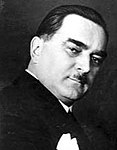| |||||||||||||||||||||||||||||||
All 373 seats in the National Assembly 187 seats needed for a majority | |||||||||||||||||||||||||||||||
|---|---|---|---|---|---|---|---|---|---|---|---|---|---|---|---|---|---|---|---|---|---|---|---|---|---|---|---|---|---|---|---|
| |||||||||||||||||||||||||||||||
 Most voted-for list by banovina | |||||||||||||||||||||||||||||||
| |||||||||||||||||||||||||||||||
Parliamentary elections were held in Yugoslavia on 11 December 1938. [1] The result was a victory for the governing Yugoslav Radical Union, which won 306 of the 373 seats in National Assembly.
Contents
These would be the last elections held in Yugoslavia before World War II. By the time of the first postwar elections, in 1945, the Communist Party of Yugoslavia was rapidly consolidating power, and the non-Communist opposition boycotted the vote after claiming to have been targeted with severe intimidation. [2] As a result, the 1938 elections would be the last multi-party elections held in Yugoslavia until the Communists gave up their monopoly of power in 1990. [3]

